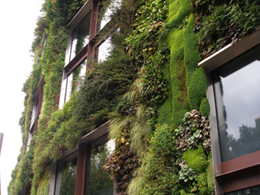COLUMNS
LANDSCAPES

07 December, 2011
Green Walls-Vertical Gardens
From the antiquity, the creation of vertical gardens preoccupied man. The term "vertical garden" refers to the planting of the facades of buildings, and generally, to vertical surfaces.
Façade greening proved to be a good solution for filtering the air inside the building, providing a kind of insulation from noise and represent aesthetic elements of particular interest. Plants can dramatically reduce the maximum temperature of a building by shading walls from the sun, the daily temperature fluctuation being reduced by as much as 50 per cent, a fact of great importance in warm-summer climate zones (Kohler 1993:130). Other benefits of green walls are the reduction of dust, the protection of the surface of the building from damage from very heavy rainfall and hail. They also help to shield the surface of the building from ultraviolet light.
One of the concepts of vertical gardens is the hydroponics' system as was pioneered by the French researcher and designer Patrick Blanc.


Photo 06a,06b. Vertical Garden. Μusee du Quai Branly. Paris 2011. Designer Patrick Blanc. Photographs by Aikaterini Gkoltsiou.
Blanc's research led him to discover the ways that plants exploit vertical surfaces in humid environments such as the tropical forest and be able to survive in the absence of soil. His system involves an outer layer of propagation felt or capillary matting, which is fixed over a waterproofing PVC sheet, that isolates the wall structure from the vegetation supporting felt. Small young plants are placed into pockets cut into the felt structure.

Photo 09. Detail of planting. Small young plants are placed into pockets cut into the felt structure. Photographs by Aikaterini Gkoltsiou.

Photo 11. Detail of planting. An outer layer of propagation felt or capillary matting is fixed over a waterproofing PVC sheet. Photographs by Aikaterini Gkoltsiou.
Planting is the final stage of creating a vertical garden. The dense planting, results in fast aesthetic solutions, while the use of small plants gives them the chance to grow well. In the planting design, massive geometric forms are not recommended. The planting in groups of two or three varieties -in zones, or in concentric circles- is suggested.


Photos 13a, 13b. Vertical Garden. Μusee du Quai Branly. Paris, 2011. Designer Patrick Blanc. Photographs by Aikaterini Gkoltsiou.
Green walls are the best alternative in those cases where there is a lack of possibility to plant in the ground and we want to cover large vertical surfaces quickly with spectacular effects. Despite the above significant bioclimatic benefits, this technology is a costly solution and many scientists do not consider it as an ecological approach, since many synthetic non-recyclable materials, water and energy for lighting are consumed. Façade greening should be part of the overall design of an area and not a panacea for replacing the creation of green clusters.
By Aikaterini Gkoltsiou
Related articles:
- Landscape design for different cultures ( 27 November, 2012 )
- Playgrounds ( 07 November, 2011 )
- New column in greekarchitects by Aikaterini Gkoltsiou ( 06 November, 2011 )
- Tourist landscapes ( 09 January, 2012 )
- Landscape architecture : hotel renovations ( 09 February, 2012 )
- Mediterranean gardens ( 10 March, 2012 )
- The role of landscape architect in agritourism landscape design ( 12 May, 2012 )
- Ιle Seguin – Rives de Seine ( 25 September, 2012 )
- ΤΑΤΟϊ: Α complete proposal for the protection and enhancement of the former Royal Estate. ( 25 October, 2012 )
- Recognising the dimension of time in the landscape ( 28 February, 2014 )










